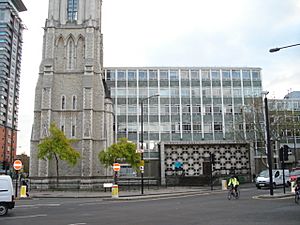Lincoln Memorial Tower facts for kids
The Lincoln Memorial Tower, also called Lincoln Tower, is a tall building in Lambeth, London. It was built in a Gothic revival style, which means it looks like old medieval castles and churches. The tower opened in 1876 to remember Abraham Lincoln, a famous American president. People from America even helped pay for it!
The tower once belonged to a group of buildings that helped people in the 1800s. Today, it's the only part left of the original design. You can find it at the corner of Westminster Bridge Road and Kennington Road. It's close to Waterloo station and Lambeth North tube station. The Lincoln Tower is now a listed building, which means it's protected for its history. It is connected to Christ Church and Upton Chapel.
How the Lincoln Tower Began
The Lincoln Tower stands on a very old site. Before the tower, there was an orphanage for girls built there in 1758. When the orphanage closed, a church called Surrey Chapel bought the land. Their old church lease was ending, so they needed a new place. This new, larger site gave them space for a new Congregational church, which they named Christ Church. They also planned many other buildings.
The pastor of Surrey Chapel at that time was Christopher Newman Hall. He was a very active person. He had spoken and written a lot to support Abraham Lincoln. He also strongly supported the end of slavery during the American Civil War. Pastor Hall raised money in America for a special memorial to Abraham Lincoln in London. He included this memorial in the plans for the new church complex.
The Lincoln Tower officially opened on July 4, 1876. This date was special because it was 100 years after America declared its independence. The first stone for the tower was laid two years earlier, on July 9, 1874. The American ambassador, General Schenk, helped with this important event. The two main rooms inside the tower were named the Washington and Wilberforce rooms.
Tower's Look and Design
The first idea for the tower came from architect E.C. Robins in 1873. He planned for the tower and its tall, pointed top (called a spire) to be above the center of the new church. However, other architects, Paull and Bickerdike, changed the final design. They kept many of Robins' ideas for the whole building complex. But they made the Lincoln Tower much more important.
The tower became a separate building with its own ground floor and entrances. It was still part of the church complex, but it stood out. As more money was raised for the memorial, the new architects made the tower even taller. They raised it to 200 feet high! The amazing spire used red and white stones. This was E.C. Robins' idea to show the 'stars and stripes' of the American flag.
Above the main entrance on the north side of the Tower, a stone was added. It clearly says Lincoln Tower. Inside the tower, there are special plaques. One plaque remembers preacher Rowland Hill, whose coffin was moved there. Another plaque remembers his successor, James Sherman. A very large plaque explains the tower's purpose. It says the tower remembers Lincoln's fight for freedom and thanks American citizens for paying half the cost. It also stands as a promise of friendship between nations.
The finished tower was built with Kentish Rag stone on the outside and Bath stone inside. Its Gothic style was admired by many. People at the time thought it was one of the best examples of tower architecture in south-central London.
The Tower Today
Sadly, much of the Christ Church complex was destroyed during the Second World War. But the Lincoln Tower survived the bombings! In the 1950s, a large office building was planned. It would include a new church and community spaces. This new building was built where the old nineteenth-century Christ Church and its school had stood.
Today, the Lincoln Tower stands next to this modern office block. The Christ Church and Upton Chapel are now part of this newer building. The old Gothic Revival tower looks very different against this modern background. The Lincoln Tower, the chapel, and the community offices are now owned by the United Reformed Church and Baptists. They are managed by Oasis Church Waterloo, which is part of the Oasis Trust charity. The chapel also works as a cafe, welcoming visitors.




